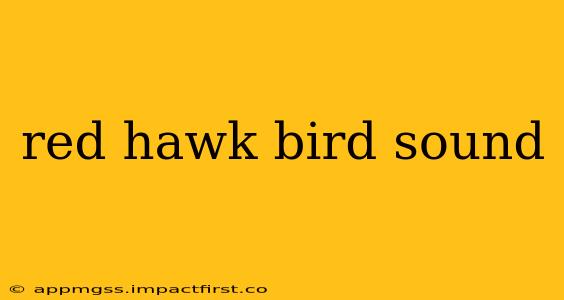The piercing cry of a red hawk slicing through the air is a sound that evokes both awe and primal instincts. These magnificent birds of prey, encompassing several species within the Buteo genus, are known for their distinctive vocalizations, which vary depending on the species and the context. Understanding these sounds provides a deeper appreciation for these impressive creatures and their role in the ecosystem. This article will explore the diverse sounds of red hawks, delve into the reasons behind their calls, and answer some frequently asked questions.
What do Red Hawks Sound Like?
This is a broad question, as the term "red hawk" encompasses several species, each with its own vocal repertoire. Generally, red hawk calls are often described as a series of high-pitched whistles, screams, and sometimes even chattering sounds. The intensity and frequency of the calls can vary depending on the situation. For example, a hawk defending its territory might emit a much more aggressive and louder call than one simply communicating with its mate.
The Red-tailed Hawk ( Buteo jamaicensis), arguably the most well-known "red hawk," is known for its varied calls. These can include a high-pitched "kee-ar," a series of shrill whistles, or a loud, piercing scream. The specific sound depends on factors such as whether the bird is calling to its mate, warning off a rival, or alerting its young to danger. You'll find numerous recordings of Red-tailed Hawk calls online which will help you differentiate them.
What are the Different Types of Red Hawk Calls?
Red hawk calls serve various purposes, and their acoustic properties reflect this functional diversity. We can broadly categorize them as:
- Contact Calls: These relatively soft calls maintain contact between mates or between parent and offspring. They are often shorter and less intense than alarm calls.
- Alarm Calls: These are typically loud, high-pitched, and far-reaching. They are used to warn others of danger, be it a predator or a rival hawk.
- Territorial Calls: Similar to alarm calls in intensity, territorial calls serve to establish and defend a hawk's hunting and nesting territory. They’re often given from prominent perches.
- Aggressive Calls: These are often harsh, grating sounds used during confrontations with rivals or intruders.
How Can I Identify a Red Hawk by its Sound?
While identifying a red hawk solely by its sound can be challenging due to the overlapping vocalizations of different species and the variability within a single species, familiarizing yourself with recordings of common red hawk calls is a good starting point. Paying attention to the context of the call – location, time of year, and the bird's behavior – can also significantly aid identification. Combining sound identification with visual observation will yield the most accurate results.
What Other Birds Sound Similar to a Red Hawk?
Several other raptors share sonic similarities with red hawks. Broad-winged Hawks, for example, possess a similar high-pitched call. However, careful listening can reveal subtle differences in tone, rhythm, and pitch that can distinguish them. Again, comparing sounds with established recordings and learning the subtleties of bird vocalizations is essential for accurate identification.
Where Can I Find Recordings of Red Hawk Sounds?
Many online resources, such as the Cornell Lab of Ornithology's Macaulay Library and Xeno-canto, offer extensive collections of bird sounds, including those of various red hawk species. These websites are invaluable tools for learning to identify bird calls and are frequently used by birders and ornithologists alike.
Conclusion
The diverse vocalizations of red hawks are a testament to their complex social and ecological roles. While pinpointing a specific species solely by sound may require practice and experience, understanding the general characteristics of their calls allows for a heightened appreciation of these magnificent birds of prey. By actively listening and learning, you can develop a sharper ear for recognizing and appreciating the unique soundscapes of nature, enriching your birdwatching adventures.
